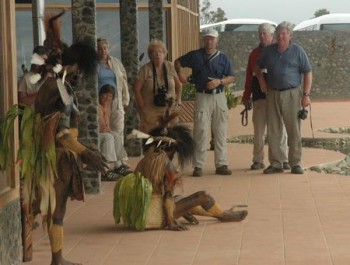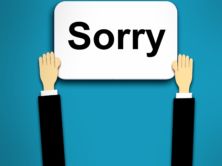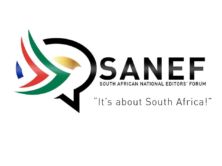
The photo was taken by Andrew Mack at a hotel near Mt. Hagen. A group of tourists is watching a skit put on by a local group of performers.
Art Science Research Laboratory’s imediaethics.org and SavageMinds.org is simultaneously cross-publishing on both web sites, a series of essays on the controversy surrounding Jared Diamond’s New Yorker article, “Annals of Anthropology: Vengeance is Ours.” The essay series titled,The Pig in a Garden: Jared Diamond and The New Yorker, is written by ethics scholars in the fields of anthropology and communications, as well as journalists, environmental scientists, archaeologists, anthropologists and linguists et al., and edited by Rhonda Roland Shearer, Alan Bisbort and Sam Eifling. Each contributor’s mission was simple: To examine Jared Diamond’s article, and The New Yorker’s decision to publish it, through the lens of their own discipline. We think you will agree that these issues will not soon be put to rest. As Nancy Sullivan writes in her contribution, part of the reason for this series is to reclaim some of the ground among general readers lost to “experts” like Jared Diamond. With this series, imediaethics.org and SavageMinds.org seek to capture that wider general audience for writings about anthropology. Mack’s essay is number two in series
* * * * * * * * *
The issue is not “what we can learn from primitive societies” but rather “what do we show of ourselves when we call a culture ‘primitive.’”
A Papua New Guinean colleague recently complained to me via e-mail that “some people/researchers from other countries think PNG is a living museum.”
When I lived in PNG, people would often ask me, “What church are you with?”, thinking I must be a missionary. Once disavowed of this assumption, a surprising number of these same people then asked, “What tribe do you study?”, thinking I must be an anthropologist. Why would so many assume that I, clearly a foreigner to PNG, was either a missionary or anthropologist? Perhaps because these two professions are typically associated with primitive cultures. Primitive people need to be taught the word of the Lord, or to be studied because doing so reveals something absent or obscured in “more advanced” societies. A quick scan of advertisements for tourist packages to PNG shows most are replete with phrases like “discover a different world,” “see primitive tribal people,” or “step back in time.” PNGeans are accustomed to visitors coming from overseas to proselytize or to study or experience “primitive” people.
PNG, and probably many other developing nations, is still commonly perceived as being profoundly different from our world. The media promulgate this perception by focusing on sensational “primitive” things such as tribal wars and penis gourds.
Tribal wars are actually not that common across the nation. PNG is home to more than 600 language groups and thousands of clans, the vast majority of whom are not warring. Try sampling 600 language groups from other nations and count how many are warring. Right now, the United States is warring with people of many tribes and languages in Iraq and Afghanistan. Could the perception of widespread warring in PNG be merely an artifact of there being so many different cultures and languages packed in one small country? Do other geographic areas with as much cultural diversity have less strife?
PNG groups rarely fight with anyone other than their neighbors. Unlike the United States, most PNG tribes have little ability to project hostilities beyond their immediate borders. Yet often the only thing “primitive” about these tribal fights is the lack of sophisticated weaponry. Give the fighting tribes grenade launchers, uniforms and tanks, and they will barely differ from our fighting men, with one major exception: PNG warring is done out of a sense of honor, familial/tribal pride, and land disputes. Tribal fighters are not paid as a professional soldier class. Weaponry and military spending are not huge segments of the PNG economy as they are in the United States. What enables Western media to sensationalize PNG’s tribal fighting is that the fighters are part of that perceived “living museum”, one that offers reflections of a primitive past that we have left behind.
This perception–that PNG is primitive and a throwback to our own ancestral history–is widespread and insidious. It warps the perception of visitors and the outside world in ways that are subconscious, extremely subtle, and damaging both to PNG and ourselves. Thinking of one culture as primitive and ours as advanced often subtly translates into a bias of our own superiority, which subconsciously affects how we relate to these supposedly primitive cultures.
“Culturism,” not racism, per se
I am deliberately avoiding the word “racism” because that has different, more conspicuous connotations. This is not about something as obvious as skin color. It is more about assumptions we in the developed world, and especially in the United States, make about other cultures. I do not know a word for it; perhaps “culturism” fits.
I am not pointing fingers. My understanding of this arises from what I have first seen in myself, and then only after years as an expatriate in PNG. This is not something I think most scientists and visitors come to appreciate easily when making relatively short visits to the country, even if fairly frequent and spread over decades. I do not mean to single out Dr. Diamond’s observations of PNG culture. To the contrary, my concern is that if commentators as intelligent and well-educated as Dr. Diamond, and intellectual media such as The New Yorker can exhibit these subtle double standards and biases, then these issues are no doubt widespread in the general population.
Before I look at Dr. Diamond’s essay, I will briefly discuss how this bias crept into my consciousness while living in PNG. It is a more profound and transformational experience to identify faults in oneself than to see them in others. Though I always paid lip service to a concept of equality among all people, it took me quite some time to realize that I carried biases I likely would have criticized in others. I think only after viscerally appreciating a bias within oneself can one really begin to expel it.
My cultural bias showed
In 1989 Debra Wright and I walked 10 hours into a wilderness from a mission landing strip surrounded by pristine forest. There we worked with a team of local men of the Pawaiia language group to build a research station by hand. We lived there the next four and a half years, emerging only three or four times a year to purchase supplies that were then packed in on strong Pawaiian backs. Working with these men, I developed a profound admiration for their strength. They carried loads that would stagger me, swung axes all day to split wood, and even dragged me out of raging rapids if I botched a river crossing.
One day, Simbai (not his real name) came to our house with a bad gash in his hand from a misplaced swing of the bush knife (what we call a machete) while cutting firewood. Deb was patching him up – washing the wound and applying a dressing – when Simbai passed out. He had fainted at the sight of his wound. At the moment I was struck with a tremendous surprise. These guys were super tough; I never imagined they would faint like that! I felt stupid that we had not thought to have him lie down while we dressed the wound.
The epiphany came when I realized I shouldn’t have been so surprised. Simbai was just like me. As I braced him and Deb finished the bandaging, I felt a truer connection to him than I had in years of living and working with him. I realized how subtle my misperceptions were, that I should think he could stand for bandaging, and then be surprised at his fainting.
Big Conservation Organizations
The more dramatic revelations and expunging of my cultural biases began when I started teaching University of PNG students. Every year for more than a decade, we took classes of 23 to 30 undergraduates into remote rainforests. It was a month of true field biology experience for these students, doing exactly the sorts of things Dr. Diamond has done on many expeditions to PNG.
For decades big conservation organizations have operated by sending foreign experts in and out of countries to guide conservation. Poor infrastructure, inadequate budgets and undertrained instructors all conspire to keep students in countries like PNG from ever reaching the expertise of foreigners like myself or Dr. Diamond.
On our courses, as we laid out our transects and plots, set traps and nets, and collected voucher specimens, I began to see firsthand that there was actually no boundary to prevent these kids from developing the expertise that I had. I began to realize that I was doing them, their nation, and conservation a disservice by residing there as an expert who advised nationals rather than teaching my expertise to nationals.
In the mid-nineties we began shifting away from pure research and toward teaching research methods. Many who were higher in the conservation echelons saw this as a radical shift. Why? I think because of the subtle bias in those echelons. They don’t quite believe, as I do, that those nationals are equally capable of doing what we foreign “experts” do. Or some think the conservation threats are so immediate that there isn’t time to train national experts and coalitions to execute their own conservation agenda. Of course, if we fully embraced the belief of full intellectual equality and worked to correct the educational shortcomings that create the apparent contrasts, Big Conservation would soon have little need for foreign experts like myself. And foreign countries would then have little need for Big Conservation. These organizations are built and are sustained upon the assumption that they need to send in experts like myself or Dr. Diamond to guide conservation among more “primitive” societies.
How The New Yorker article demonstrates the larger problem
So how does this relate to an article about vengeance by Dr. Diamond in The New Yorker? First, my complaints are not directed to Dr. Diamond, whom I greatly respect as an ecologist and physiologist. My complaints are directed at Big Conservation and how it operates in places such as PNG. As I did for many years, Dr. Diamond is merely working for a broken machine. The article does suffer from ethical problems. But the ultimate causes of those problems are among the root causes for the failure of Big Conservation in countries like PNG – i.e., a subtle cultural bias that lower reporting standards that are acceptable for “primitive” societies than for our own society.
Had Dr. Diamond been writing about the vengeance wreaked by a Los Angeles gang member, he would surely have changed the subject’s name to protect him from retribution. Writing about a PNG informant, Dr. Diamond did not think this standard journalistic protection was necessary. His decision might seem to just be a lapse in journalism, but more importantly, I think it reflects a subtle cultural boundary.
Having lived in PNG, it is easy for me to see how Dr. Diamond could have done this. I myself might once have thought, “He’s a guy in a very far off and remote world; an article in the The New Yorker would never affect him.” It took me years of contact with a wide cross-section of the PNG populace to really appreciate that, no, his world shares much with the world of The New Yorker. It took me far too long to realize I should not treat an injured PNG woodcutter differently than I would an American, physically stronger or not. I wonder if, without the benefit of that experience, New Yorker writers and editors might think it acceptable to apply a different standard than they would for say, the story of a New York chauffer. Possibly the editors do not think it is as important to check facts and protect identities for primitive, tribal “them” as for sophisticated “us.”
It appears to me that Dr. Diamond widely paraphrased in his own words those attributed to Mr. Wemp as quotations. Perhaps the actual words spoken by Mr. Wemp would not sound as convincing, or tell the story as elegantly as Dr. Diamond presented it? Mr. Wemp probably speaks several languages, and English is most likely not his first, as the case with majority of PNG people. In most situations in PNG, people speak tok pisin, a Creole of around a thousand words with no verb tenses. Tok pisin syntax often shapes its speakers’ less-used English, making the latter sound simple and ungrammatical. Possibly it seemed “touching up” Wemp’s narrative a bit would not be misplaced since Daniel had not benefited from a good education.
Was it just poor journalism? I think not. Dr. Diamond is a prize-winning author. I do not think he would have rephrased quotations from a conversation with a Manhattan chauffeur who bragged about murders he committed as a youth. Diamond would let that man’s words speak for themselves, and speak for themselves anonymously to protect the chauffeur.
How could a writer of Diamond’s stature and an iconic magazine like The New Yorker publish a story so heedless of the consequences to the subject? I think what is at issue here is more than an example of poor journalism and even sloppier editing and fact checking. I believe the story stems from a subtle bias many of us have against a strongly tribal nation such as PNG. We equate tribal with primitive.
As a conservation biologist I am troubled at how the biases that lead to different standards of journalism can also affect important policies. Conservation organizations based in New York or Washington, D.C., much like magazines based there, develop their policies on the subtle assumption of superiority.
The editors and fact checkers probably know relatively little about the country, other than travel magazine photographs of men wearing penis gourds and colorful feathers in their hair. Removed from the real individuals mentioned in the article, their subtle biases and misconceptions clouded their judgment. I have witnessed similar situations with more far-reaching consequences as a conservationist, where major decisions are made and policies are set in the United States by people who have never been to New Guinea. And just as the people involved in this article might protest they have done nothing wrong, so might the conservation leaders who set policies for far-off peoples and cultures they’ve never encountered.
What does it mean to be a living museum?
All of this underscores the statement of my friend that many foreigners see PNG as a living museum.
One the most appealing aspects of museums is that the exhibits found in them are different from the people viewing them on the other side of the glass. If both sides of the display case were identical, the museum would have no purpose.
Acknowledging one’s cultural biases can be difficult – even painful. When those biases apply to cultures made up of people from different racial origin, they mimic racism, but are not quite the same. It isn’t because the people of PNG are brown-skinned that many outsiders look upon them differently; it is because they are tribal and, thus, perceived to be primitive. I believe with honest introspection, and perhaps a few epiphanies (such as when supermen faint at the sight of their own blood), that it is possible to eliminate the subtle cultural biases that make us feel we are different from other people and subtly superior to them.
If we can recognize the hallmarks of cultural bias within us, we can take the proper steps to correct it. Conservation might actually begin to happen when the big organizations invest in making their United States-based experts, and themselves, redundant by building expertise among the “primitive”. Writers would apply the same ethics and standards as they would for American subjects. Editors and fact-checkers would not cut corners on stories about voiceless “museum pieces.”
No culture can view another without some form of bias. It affects how scientists treat people of other cultures and how journalists and editors treat them as well. Unintentionally, the tainted writing perpetuates the biases. This is not just about sloppy journalism or editing; it is about what caused the sloppiness, and there will remain a bit of it in all of us until we acknowledge our biases and actively strive to eliminate them.
Andrew Mack: is the first William and Ingrid Rea Conservation Biologist, a position endowed by the Heinz Endowments at the Carnegie Museum of Natural History. He lived in Papua New Guinea most of the past 20 years studying and teaching ecology, and mentoring conservation research by Papua New Guinean students. Although he has published widely and had two species (a frog and a mahogany) named in his honor, he is most proud of the students he mentored who have gone on to earn postgraduate degrees in top universities. Many of them have formed a national organization dedicated to training younger students and providing national leadership in conservation. He now lives on a farm in western Pennsylvania and oversees research, conservation and education at the 2200 acre Powdermill Reserve. He is writing a book based on his experiences in Papua New Guinea.






